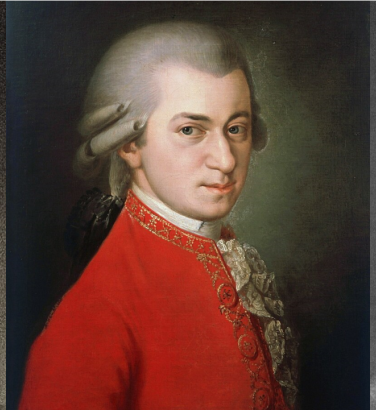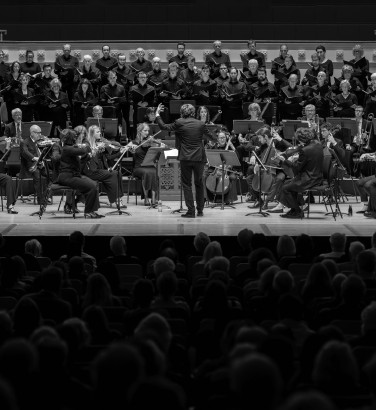
Mozart and the development of the piano concerto
1 Jul 2024
News Story
Haydn is generally accepted as the father of the symphony and the string quartet, having almost single-handedly developed both into their first recognisable forms. By the same criterion, Mozart should be acknowledged as having achieved this with the piano concerto, in which he took more interest than most of his contemporaries.
This fostering of the genre came hand-in-hand with the fortepiano emerging as an alternative to the harpsichord - the prime difference lying in the latter's strings being plucked, as opposed to their being struck with small hammers in the new instrument. The harpsichord had been ubiquitous during the Baroque era, providing harmonic support to the orchestra as part of the continuo group, but only rarely featuring as a solo instrument with orchestra, possibly because its sound did not carry as well as other instruments.
Bach is of course the great exception to this rule, but arguably of greater importance is the lasting contribution he made to the genre in his Brandenburg Concerto No 5. This work includes the first known instance of a cadenza, a long unaccompanied passage in which the soloist has the opportunity to develop the musical ideas heard up to this point, all while showing off their virtuosity. This solo display would quickly be adopted across the board (including in opera arias) and for some decades it was taken as granted that the performer would improvise it on the spot as further evidence of their skill. In this first instance, however, the cadenza is written out, as they would be once again when they graduated to become an integral part as the musical argument instead of a flashy display.
This, however, lay far in the future. Mozart’s very first compositions were for solo keyboard (probably the harpsichord), showing his early facility with this kind of instrument, and his first keyboard concertos were arrangements of music by other composers. They are largely disregarded today, for all that they undoubtedly provided valuable experience for the young composer.
A word before we go on about the numbering of Mozart’s piano concertos. Received wisdom tells us that he wrote 27, but this includes one for two pianos (No 10 in E flat), another for three (No 7 in F) as well as seven arrangements: Nos 1-4 and a further three (of sonatas by Bach’s son Johann Christian) which for some reason are not numbered. This leaves us with 21 canonical original concertos: Nos 5, 6, 8, 9 and 11-27 – but as we have seen with symphonies, it’s probably best to leave their numbering well alone.
It's also worth noting that opinions differ on when Mozart started writing his keyboard concertos for piano rather than harpsichord. The point when they move from being arrangements to his own compositions is a convenient one, but a good deal of the music in the first of his original keyboard concertos still works perfectly well on the harpsichord. Part of this may have been down to canny marketing, ensuring that the music had a wider reach by being playable on all keyboard instruments, old and new-fangled alike.

The beginning of the second movement from Mozart's Piano Concerto No 21 (in the original manuscript)
At any event, the first keyboard concerto unequivocally by Mozart is No 5 in D (1773), which he wrote aged 17. He wrote fondly of this piece in later years, and his having composed an alternative finale nine years later (the Rondo in D, K382) shows that it is far from an early work that can safely be overlooked in the light of his later masterpieces. That said, No 9 in E flat (1777) was the first to show signs of his genius in the genre. There’s a startling innovation in the piano being heard as early as the second bar – as a rule, the soloist only came in once the orchestra had presented all the first movement’s themes – but more significantly in the wider context of the Mozart piano concerto, it was the first with a slow movement written in a minor key, loaded with tragic undertones.
Mozart spent much of the late 1770s on the road or champing at the bit at home in Salzburg, and did not turn his attention back to the piano concerto until he moved to Vienna in 1781. Most of them would now be written primarily for himself to perform, a showcase of his skills as both composer and pianist, but the first few were a deliberate ploy to attract a key market. Nos 11-13 are in fact designed so that the wind and brass instruments (as well as the timpani in No 13) can be left out altogether, meaning they could be performed in the domestic sphere, by piano and string quartet. No 12 in A – which Maxim Emelyanychev and SCO Principals performed in its chamber version at the 2024 Edinburgh International Festival – is the standout from this set, giving the clearest foretaste of the masterpieces to come.
1784 proved a truly exceptional year, with Mozart premiering no fewer than 6 piano concertos (Nos 14-19). One of the most important features of his mature piano concertos, the importance of the woodwind instruments, finally emerges during this set, and their dialogue with the soloist proves one of the enduring delights of these works. As for the half-dozen true classics (Nos 20-25) which emerged over the next two years, everyone will have their favourites, but it would be remiss not to draw attention to the only two of the entire canon to be written in minor keys: No 20 in D minor and No 24 in C minor rank among the darkest and most dramatic music Mozart ever wrote.
Following the success of The Marriage of Figaro in mid-1786, Mozart started to focus increasingly on opera and (following an appointment at the Imperial court) chamber music, though he did compose another two piano concertos, in 1788 and 1791. Their reputation isn’t quite on a par with that of the concertos of the mid-1780s, but that is more a comment on how extraordinary that particular cycle was. Mozart may not have created the piano concerto as such, but he raised it more or less single-handedly to unparalleled new heights. There have been countless others written since, some of which are likely more popular – Rachmaninov’s come to mind here – but these contributions to the genre would have been impossible without Mozart’s flair and genius to set the ball rolling.
Related Stories
![Three men, the first two in 18th century formal dress (one in black and white, one in a red coat), the last in an old photo, smoking]()
What is a sinfonia concertante?
17 March 2025
We delve into the history of a hybrid genre ...![]()
The SCO Chorus on music for Lent
10 March 2025
With Easter just around the corner, we delve into perhaps the richest (and often darkest) choral repertoire of all ...![]()
The bassoon concerto
3 March 2025
For the last article in our concerto series (for now), we turn to an instrument too often dismissed as the orchestra's resident joker.


